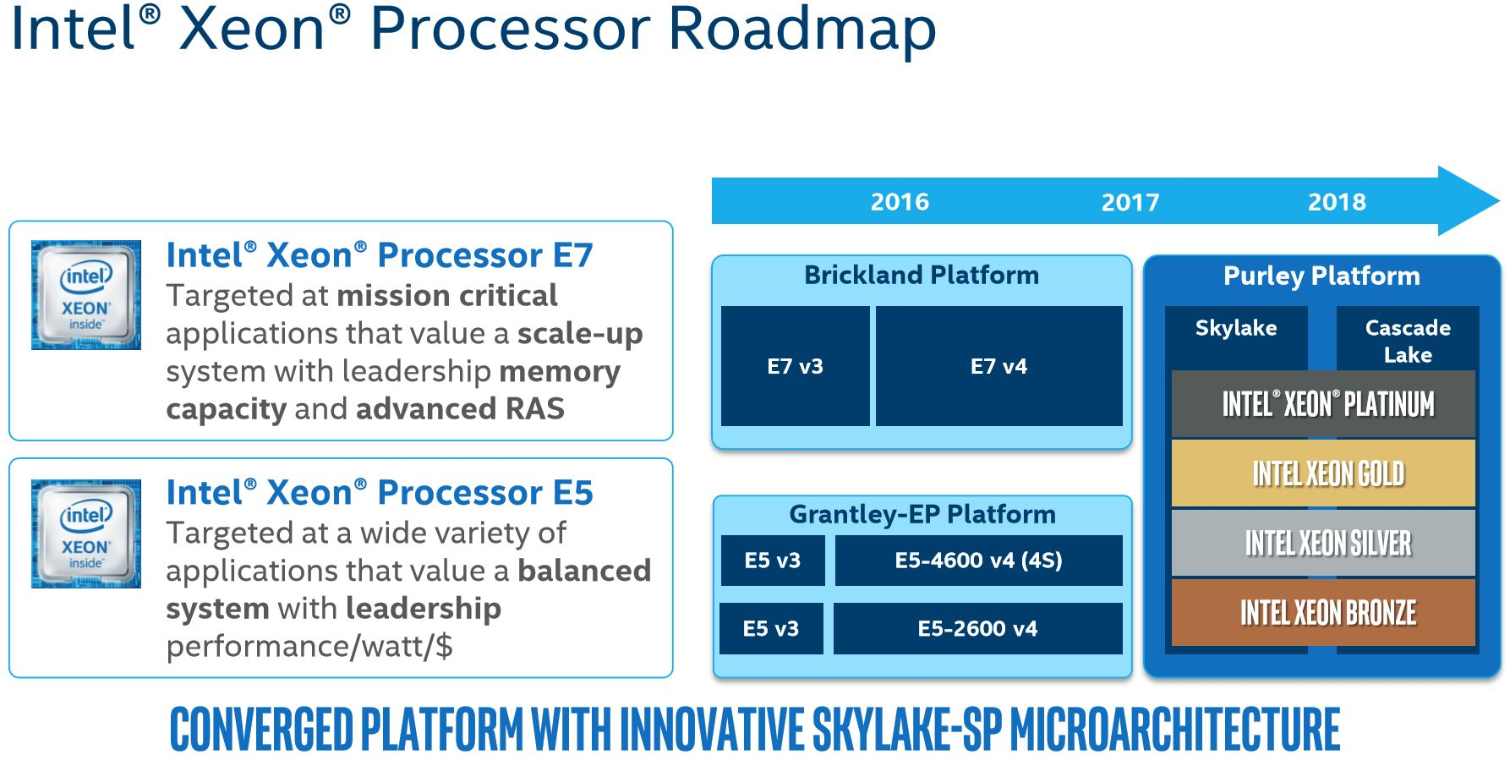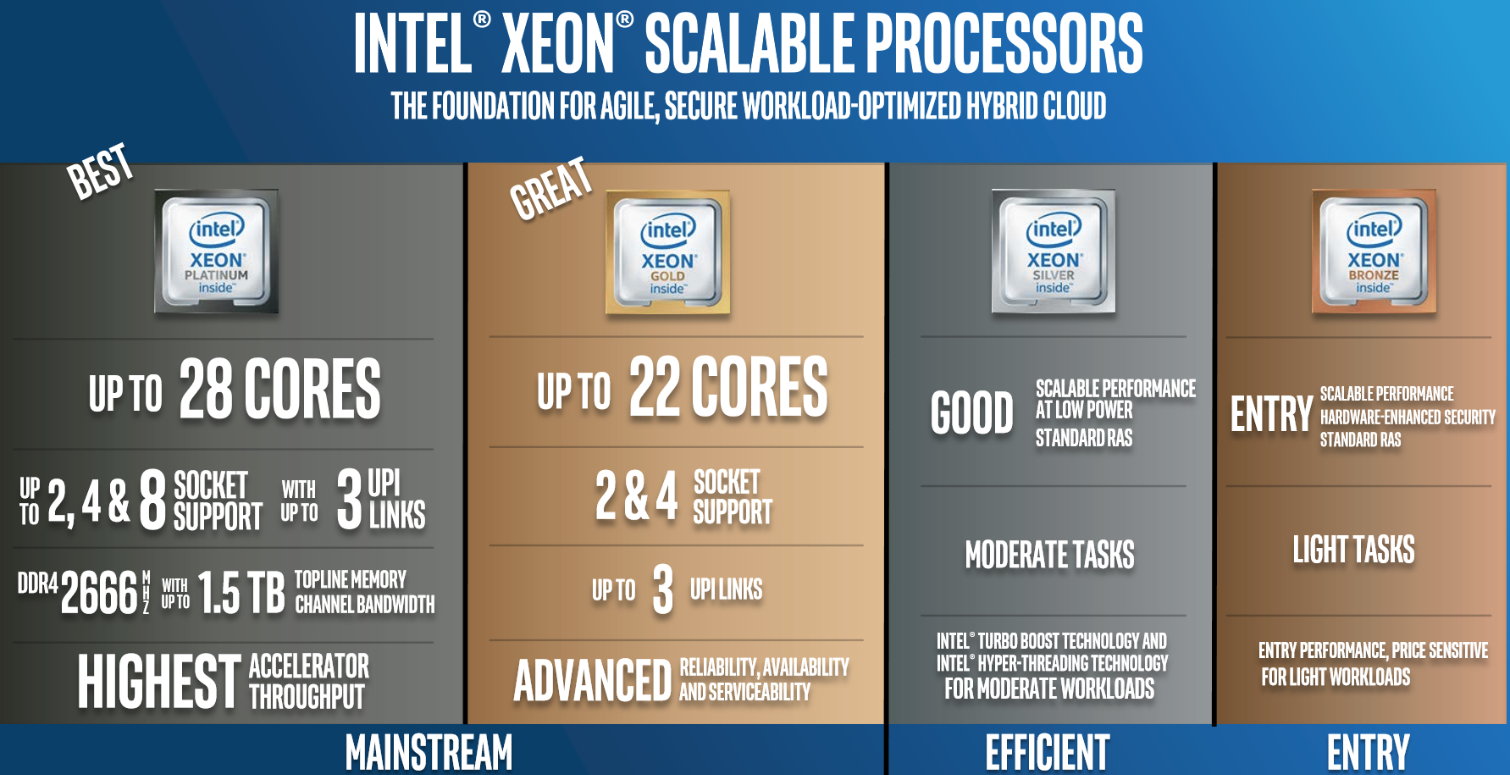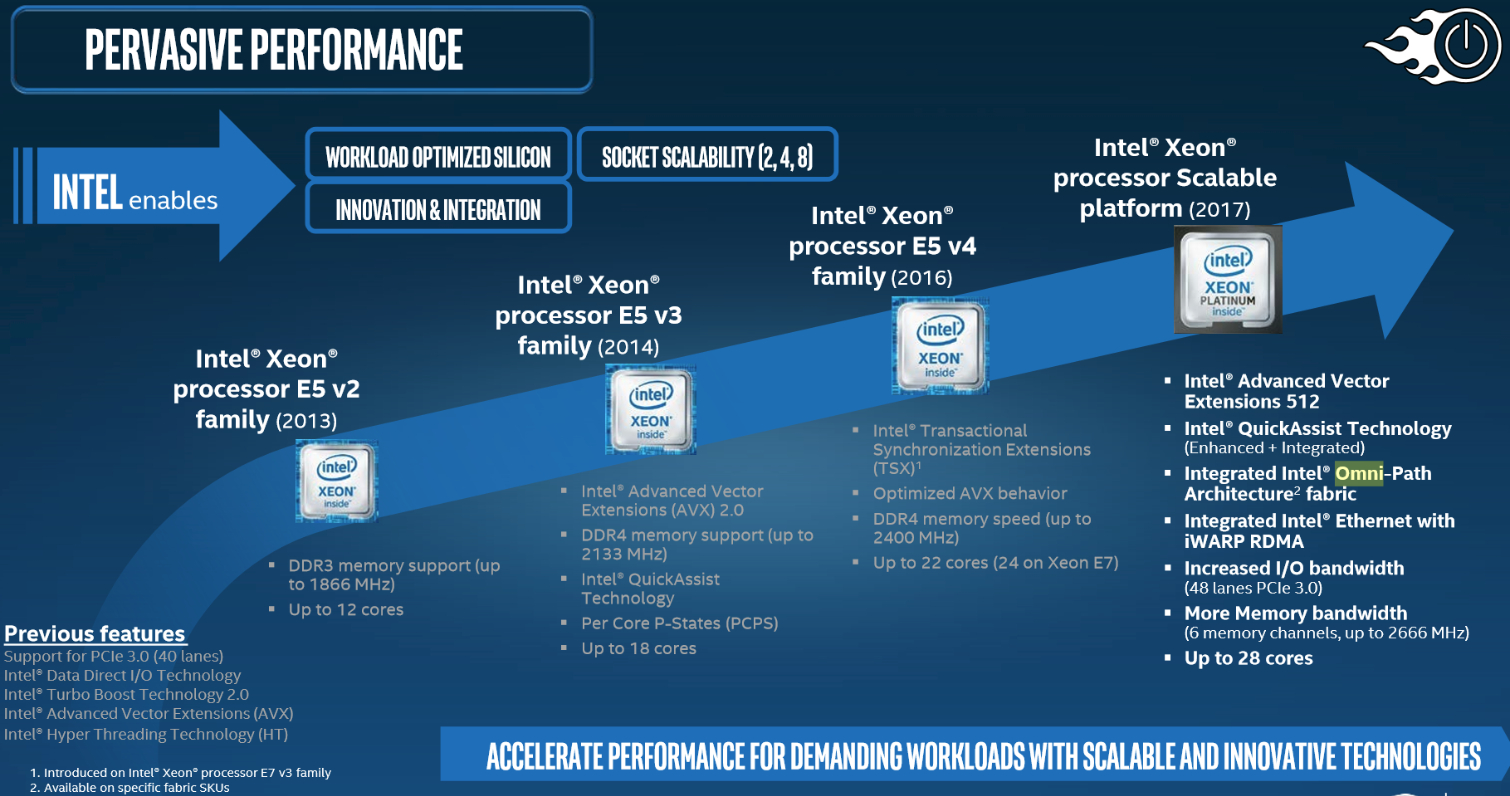Intel Xeon Platinum 8176 Scalable Processor Review
Why you can trust Tom's Hardware
Rebranding Xeon
Previously, Intel split its Xeon SKUs into the E5 and E7 families. But as part of an initiative to provide one platform for all needs, the company combined disparate line-ups into one unified Scalable Processor stack. The new philosophy also carries over to the launch cadence; all 2P, 4P, and 8P models are being introduced at the same time, rather than in segments. We do appreciate the consolidation, even if this means covering 58 CPU models simultaneously. Then again, we're actually looking at fewer SKUs than what you found previously in the old E5 and E7 portfolios.












This generation is broken up into Platinum, Gold, Silver, and Bronze categories, addressing the mainstream, power-efficient, and entry-level markets. In the past, Intel drew its line between the Brickland platform for Xeon E7 models and Grantley-EP for the E5 SKUs. Today's Skylake-based CPUs all centralize on the same Purley platform, employing one socket interface and chipset foundation. Intel will carry the new line-up into the Cascade Lake era, as well.
Intel achieves segmentation through several variables, including core count, base frequencies, PCIe connectivity, memory capacity/data rates, AVX-512 functionality, Hyper-Threading, UPI connections, and FMA units per core. In other words, you pay every penny for every single feature you get.
For instance, many models only have one FMA floating-point engine per core, while others have two. Intel sub-divides its Gold series, designed for two- and four-socket servers, into the 61xx and 51xx processors. The latter sports fewer cores, UPI links, restricted memory support, and only one FMA per core. The Bronze series lacks Hyper-Threading and Turbo Boost; getting those features requires stepping up to the Silver series.
The naming sequence starts at 3xxx and ends with 8xxx, skipping the 7xxx series already reserved for Intel's Xeon Phi products. Power-wise, these host processors range from 70W to 250W. An "F" modifier indicates fabric-equipped models that support Omni-Path. There isn't an official time frame yet, but we'll soon see "P" models representing Programmable FPGA-equipped Xeons.



Intel notes that it designed these CPUs with security, performance, and agility/orchestration in mind. The final three slides list the features added over the years to improve those areas of focus.
MORE: Best CPUs
Get Tom's Hardware's best news and in-depth reviews, straight to your inbox.
MORE: Intel & AMD Processor Hierarchy
MORE: All CPU Content
Current page: Rebranding Xeon
Prev Page Intel Redefines Xeon Next Page Into The Core And Cache, AVX-512
Paul Alcorn is the Editor-in-Chief for Tom's Hardware US. He also writes news and reviews on CPUs, storage, and enterprise hardware.
-
the nerd 389 Do these CPUs have the same thermal issues as the i9 series?Reply
I know these aren't going to be overclocked, but the additional CPU temps introduce a number of non-trivial engineering challenges that would result in significant reliability issues if not taken into account.
Specifically, as thermal resistance to the heatsink increases, the thermal resistance to the motherboard drops with the larger socket and more pins. This means more heat will be dumped into the motherboard's traces. That could raise the temperatures of surrounding components to a point that reliability is compromised. This is the case with the Core i9 CPUs.
See the comments here for the numbers:
http://www.tomshardware.com/forum/id-3464475/skylake-mess-explored-thermal-paste-runaway-power.html -
Snipergod87 Reply19926080 said:Do these CPUs have the same thermal issues as the i9 series?
I know these aren't going to be overclocked, but the additional CPU temps introduce a number of non-trivial engineering challenges that would result in significant reliability issues if not taken into account.
Specifically, as thermal resistance to the heatsink increases, the thermal resistance to the motherboard drops with the larger socket and more pins. This means more heat will be dumped into the motherboard's traces. That could raise the temperatures of surrounding components to a point that reliability is compromised. This is the case with the Core i9 CPUs.
See the comments here for the numbers:
http://www.tomshardware.com/forum/id-3464475/skylake-mess-explored-thermal-paste-runaway-power.html
Wouldn't be surprised if they did but also wouldn't be surprised in Intel used solder on these. Also it is important to note that server have much more airflow than your standard desktop, enabling better cooling all around, from the CPU to the VRM's. Server boards are designed for cooling as well and not aesthetics and stylish heat sink designs -
InvalidError Reply
That heat has to go from the die, through solder balls, the multi-layer CPU carrier substrate, those tiny contact fingers and finally, solder joints on the PCB. The thermal resistance from die to motherboard will still be over an order of magnitude worse than from the die to heatsink, which is less than what the VRM phases are sinking into the motherboard's power and ground planes. I wouldn't worry about it.19926080 said:the thermal resistance to the motherboard drops with the larger socket and more pins. This means more heat will be dumped into the motherboard's traces.
-
bit_user ReplyThe 28C/56T Platinum 8176 sells for no less than $8719
Actually, the big customers don't pay that much, but still... For that, it had better be made of platinum!
That's $311.39 per core!
The otherwise identical CPU jumps to a whopping $11722, if you want to equip it with up to 1.5 TB of RAM instead of only 768 GB.
Source: http://ark.intel.com/products/120508/Intel-Xeon-Platinum-8176-Processor-38_5M-Cache-2_10-GHz -
Kennyy Evony jowen3400 21 minutes agoReply
Can this run Crysis?
Jowen, did you just come up to a Ferrari and ask if it has a hitch for your grandma's trailer? -
bit_user Reply
I wouldn't trust a $8k server CPU I got for $100. I guess if they're legit pulls from upgrades, you could afford to go through a few @ that price to find one that works. Maybe they'd be so cheap because somebody already did cherry-pick the good ones.19927274 said:W8 on ebay\aliexpress for $100
Still, has anyone had any luck on such heavily-discounted server CPUs? Let's limit to Sandybridge or newer. -
JamesSneed Reply19927188 said:The 28C/56T Platinum 8176 sells for no less than $8719
Actually, the big customers don't pay that much, but still... For that, it had better be made of platinum!
That's $311.39 per core!
The otherwise identical CPU jumps to a whopping $11722, if you want to equip it with up to 1.5 TB of RAM instead of only 768 GB.
Source: http://ark.intel.com/products/120508/Intel-Xeon-Platinum-8176-Processor-38_5M-Cache-2_10-GHz
That is still dirt cheap for a high end server. An Oracle EE database license is going to be 200K+ on a server like this one. This is nothing in the grand scheme of things.
-
bit_user Reply
A lot of people don't have such high software costs. In many cases, the software is mostly home-grown and open source (or like 100%, if you're Google).19927866 said:An Oracle EE database license is going to be 200K+ on a server like this one. This is nothing in the grand scheme of things.